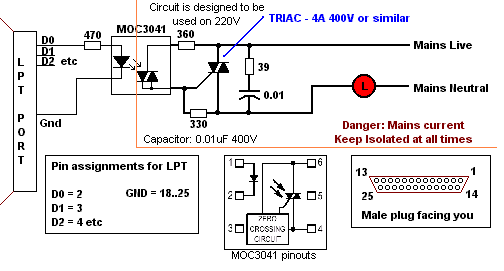After reading those 500 pages probably you might looking for something like this


I use similar circuit 24h a day with small heat sink on BTA16 triac it drives small air conditioning 230VAC fan.
However, at 5V I put 330 Ohm resistor to get around 11mA current on left side of MOC3041 (about 1.2V voltage drop on internal MOCxxx 1-2 pins diode), since this is not low current version (MOC3043 has lower typical 5mA) and in place of one 360 Ohm resistor I put two 1W 180 Ohm, to minimalize a chance to get any arcing on short one small 360 resistor.
Note: Did not tested it with LPT-I used classic LM7805 as 5V power supply, no need for PC controll in my case.